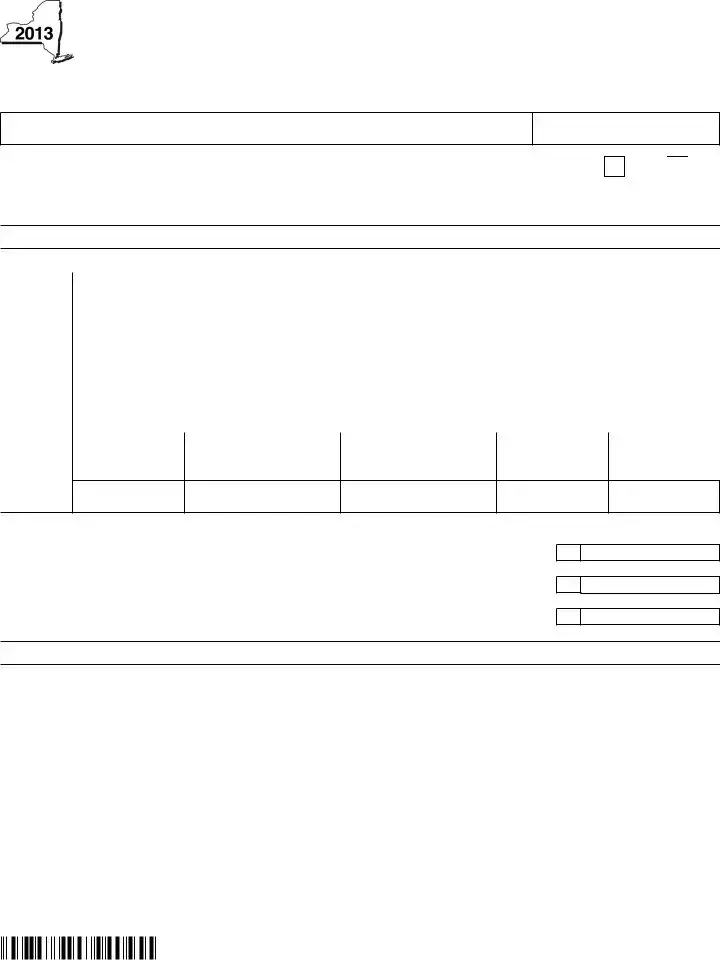The Form IT-201, "Resident Income Tax Return," is similar to the NYS IT-255 form in that both are used by New York State residents when filing their income taxes. The IT-201 form is the primary document for individuals to report their annual income and calculate taxes owed or refunds due, while the IT-255 form is specifically for claiming a tax credit for solar energy system equipment. Both forms require personal information and financial details relevant to the taxpayer's income and tax situation.
Form IT-203, "Nonresident and Part-Year Resident Income Tax Return," shares similarities with the IT-255 form, as individuals use it to file their taxes in New York State when they do not reside there the entire year. Like the IT-255, which is submitted alongside the IT-201 or IT-203, the latter form collects detailed information on the taxpayer's income earned in New York State, deductions, and credits, including those related to energy efficiency or investment, such as the solar energy system equipment credit.
The Form IT-270, "Application for Automatic Six-Month Extension of Time to File for Individuals," while primarily used for requesting an extension on filing income tax returns, is similar to the IT-255 in its supplementary role in the tax filing process. Both forms assist taxpayers in managing their tax responsibilities—IT-255 by providing a way to claim a credit, and IT-270 by offering extra time to file returns, including those that might claim such credits.
IRS Form 5695, "Residential Energy Credits," serves a similar purpose to the IT-255 but on a federal level. This form allows taxpayers to claim credits for qualified solar electric property costs among other energy-saving improvements to their homes. Just like the IT-255, Form 5695 requires detailed information about the costs involved and the dates of service installation to calculate the credit amount.
Form DTF-624, "Claim for Clean Heating Fuel Credit," is akin to the IT-255 form as both support New York State’s initiative to encourage environmentally sustainable practices. The DTF-624 form specifically provides a credit for the purchase of bioheat for heating purposes, requiring documentation of the purchase similar to how the IT-255 form necessitates details of the solar energy system.
Form IT-212, "Investment Tax Credit," relates to the IT-255 as it is another form used to claim a tax credit in New York State, albeit for different types of investments, including property, equipment, or other capital expenditures. Both IT-212 and IT-255 require taxpayers to provide specifics about their investments, including costs and service dates, to calculate the allowable credit.
The IT-2 form, "Summary of W-2 Statements," while not a claim form for credits, shares the feature of being a supplementary form necessary for processing certain individual income tax returns in New York State, similar to the IT-255. Taxpayers use the IT-2 to summarize W-2 information when filing their state tax returns, which might include claims made on forms like the IT-255.
Form IT-112-R, "New York State Resident Credit," offers similarities with the IT-255 in that it targets New York State residents looking to claim a credit, this time for taxes paid to other states. Both forms require detailed financial information and have the broader goal of providing tax relief based on specific qualifying conditions.
Form IT-216, "Claim for Child and Dependent Care Credit," parallels the IT-255 form in its purpose of providing tax relief to eligible New Yorkers. While IT-216 focuses on expenses related to child and dependent care, IT-255 is concerned with solar energy system equipment. Both forms involve calculating a credit based on expenditures and adding that credit to the taxpayer's return.
Last but not least, Form IT-249, "Claim for Long-Term Care Insurance Credit," shares common ground with the IT-255 as both target individuals seeking to reduce their tax liability through specific personal investments, in this case, premiums paid for long-term care insurance. Similar to the solar equipment credit, the long-term care insurance credit requires documentation of the expenses to qualify.

